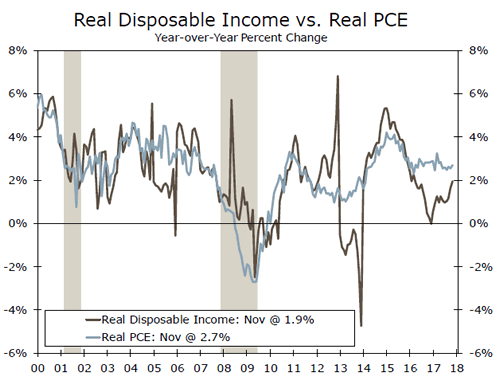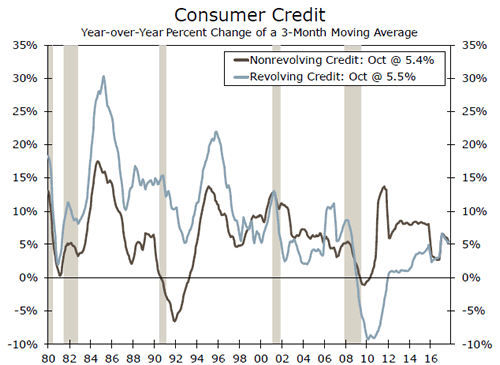U.S. Review
Hot Data Releases Warm the First Week of 2018
- In the first major data release of the year, the ISM manufacturing index soared to its second fastest pace of expansion in six years. New orders fueled the rise, which bodes well for momentum to start 2018. The service sector is also expanding, though the ISM non-manufacturing index slipped in December to 55.9.
- Construction spending and factory orders continue to support our call for a solid Q4 GDP print of 2.5 percent.
- This morning’s jobs report was somewhat softer than expected but still highlighted the strength of the U.S. labor market, which added 148,000 jobs in December. The jobless rate held steady to end 2017 at 4.1 percent.
Economic Data Escapes the Freeze
The ISM manufacturing index for December remained in solid expansion territory, coming in at a balmy 59.7 to extend a five-month streak above 58. The last time the index posted such a run was in 2004, then 1987 prior to that. Activity rose across most sub-categories, particularly new orders, which surged to its 13-year high point. That suggests solid momentum to start 2018. Factories already appear to be having trouble keeping up with orders, as evidenced by the elevated readings for both supplier deliveries and order backlogs. That also allowed for some much needed pricing power, as prices paid rose 3.5 points to 69. International demand was also a large contributor to the increase in orders, as improving economic conditions abroad continue to buoy exports. Better economic fundamentals abroad combined with continued business optimism domestically have set the stage for a strong start to the new year for manufacturers. We will be watching the hard data for orders closely in coming months as they have yet to mirror the ISM outlook. Still, the December ISM report suggests some upside risk to our equipment forecast.
Construction outlays continued to increase in November, notching the fourth-straight month of total spending growth. Strength stemmed from a bevy of sectors. Public spending continued to build on the rise fueled by storm repairs, but it remains down on a year-to-date basis. Residential outlays were strong in November, specifically for single-family homes and remodels and repairs. Multifamily building was down on the month but positive year to date. Strength going forward is likely to come from the singlefamily market, as multifamily has largely topped out this cycle. Total construction spending was up at a strong 8.8 percent three month average annualized growth rate, which bodes well for Q4 GDP growth. We expect residential investment rose 9 percent.
This morning’s jobs report was lukewarm relative to consensus expectations. There were 148,000 net new jobs created in the last month of 2017, and revisions to previous months put the average gain over the past three months at 203,700 jobs. That is the highest three-month average posted since September 2016 and suggests solid momentum to start 2018. The U.S. labor market added 2.055 million jobs over the year. That marks a deceleration from previous years of the cycle, which is to be expected given how low the unemployment rate has drifted. The national unemployment rate held steady to end 2017 at 4.1 percent, 0.6 points lower than a year ago. The labor force participation rate was unchanged over the period. Wage gains perked up in December, rising 0.3 percent on the month. Wage growth remains lackluster over the year, rising 2.5 percent from December 2016. The low unemployment rate should put more upward pressure on wages in 2018. We expect the unemployment rate will move even lower over the next year to end 2018 at 3.8 percent.
While the 148,000-job gain was lower than even our belowconsensus expectations for December, the industry detail showed jobs that were added were in a broad range of sectors. Retail trade was the only major sector to post a decline, which likely reflects the shift away from brick and mortar holiday staffing.
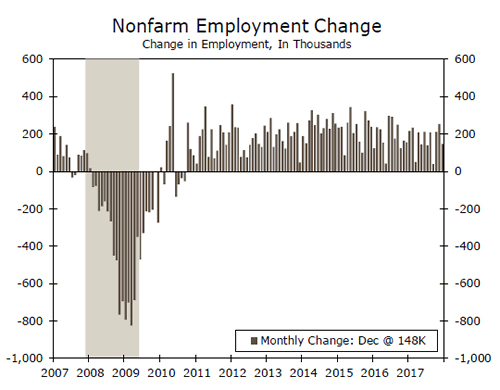
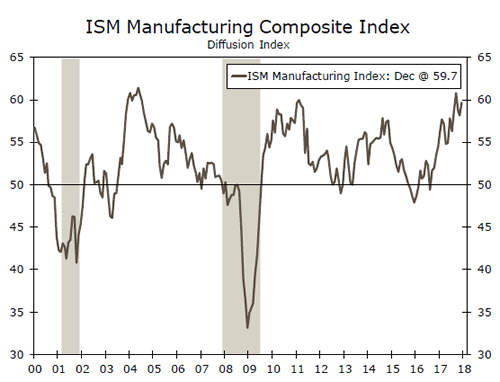
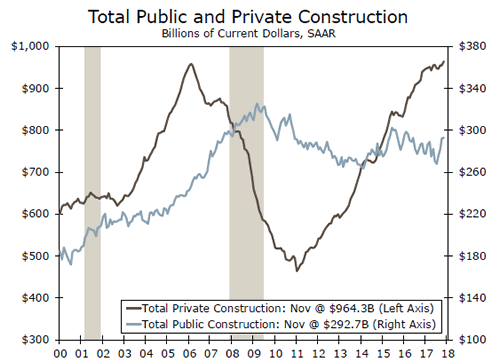
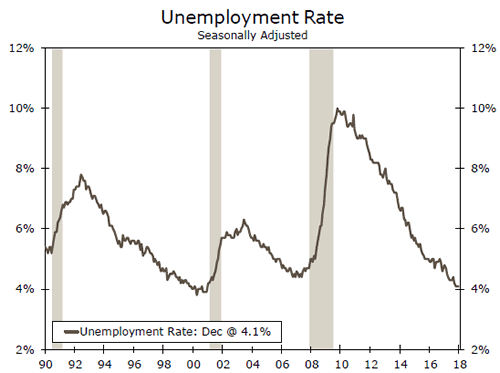
U.S. Outlook
CPI • Friday
Consumer price inflation data for December are slated to be released this coming Friday. Consumer price inflation firmed in November, with the CPI index rising 0.4 percent. That pushed the year-ago rate up to 2.2 percent compared to 1.7 percent last November. While the headline gain was in line with expectations, the 0.1 percent rise in core inflation was weaker than anticipated. However, core inflation has been picking up on trend, with the three-month annualized rate coming in at 1.9 percent. With much of the weakness in November core inflation coming from the more volatile components, we continue to expect inflation to trend higher in the coming months.
The Fed’s preferred measure of core inflation, the PCE deflator, has reached or surpassed the Fed’s 2.0 percent target in only five months of the current expansion. As inflation should more clearly pick up in the coming months, we expect the FOMC will continue on with its gradual pace of tightening in the year ahead.
Previous: 2.2% Wells Fargo: 2.1% Consensus: 2.1% (Year-over-Year)
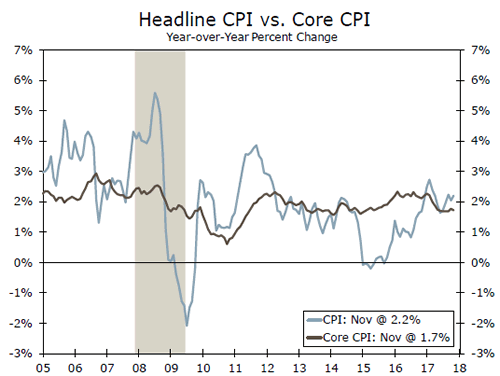
Retail Sales • Friday
The recent solid string of retail sales prints is giving more credence to the strong consumer confidence numbers. Retail sales figures for December are set to be released this coming Friday. With the 0.8 percent increase in retail and food services sales in November, plus the upwardly revised October number, from 0.2 percent to 0.5 percent, the last quarter of the year is shaping up to end 2017 on a joyful note.
Perhaps the most market-changing release in November was the strong control group sales print. Control sales, which are retail sales less food services, gas, automobiles and building materials, and used for the calculation of GDP, surged 0.8 percent in the month. We expect another strong performance by the U.S. consumer during the last quarter of the year based on the monthly data. Likewise, we look for this strength to continue into Q1-2018.
Previous: 0.8% Wells Fargo: 0.5% Consensus: 0.4% (Month-over-Month)
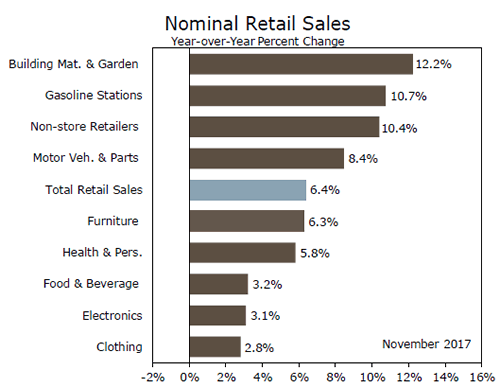
Business Inventories • Friday
This coming Friday is a busy day in the world of economic indicators as business inventory data for November are also set to be released. In October, and for only the second time this year, businesses dialed back inventories on the month. The entire decline was in the wholesale sector, which was down 0.5 percent. Retailers were flat and manufacturers actually increased stockpiles 0.2 percent. Within retail, it was a mixed picture with declines in autos offset by gains in other areas. Sales posted a 0.6 percent overall increase with gains of roughly the same magnitude across retail, wholesale and manufacturing.
After a big 0.8 percentage point boost to Q3 GDP, October’s print suggests less support from inventories in Q4. November’s data will help us forecast the net effect of the inventory line on the final GDP release of 2017.
Previous: -0.1% Wells Fargo: 0.3% Consensus: 0.3% (Month-over-Month)
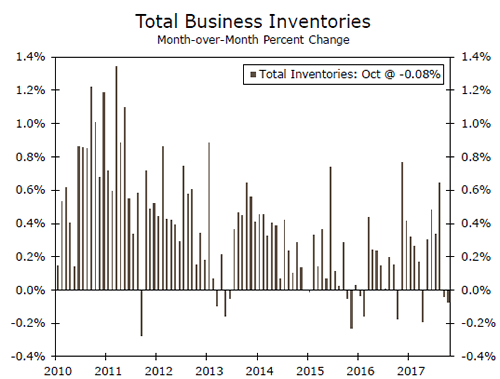
Global Review
Global Economic Growth Looks Sustainable for Now
- The expansion in the global economy looks promising and sustainable for now with manufacturing activity remaining strong and in some instances improving as 2017 came to an end.
- Brazilian industrial production increased 0.2 percent in November sequentially and by a strong 4.7 percent on a yearearlier basis. Both October’s month-over-month and year-over year changes were revised up, from 0.2 percent to 0.3 percent and from 5.3 percent to 5.5 percent, respectively.
- In Chile, the monthly economic activity index increased a strong 0.7 percent in November after declining 0.3 percent in October, both sequentially and in seasonally adjusted terms.
Global Economic Growth Looks Sustainable for Now
The expansion in the global economy looks promising and sustainable for now with manufacturing activity remaining strong and in some instances improving as 2017 came to an end. This is good news for overall economic growth expectations for 2018 and presages more changes coming to a "theater-near-you" in the coming months and quarters as policymakers, but especially monetary policymakers across the world, continue to revise their views regarding quantitative easing programs and interest rates. This policy accommodation has served as the backbone of the global economy since the Great Recession in 2008 and 2009.
These revised expectations from policymakers will probably determine the levels of volatility in markets across the world as analysts continue to gauge the prospects for potentially more tightening across the world. For now, certainty in this shift is clear in the United States, as the Federal Reserve continues its tightening campaign, but it is not that clear from other large central banks in the rest of the world.
Meanwhile, geopolitical risks may also be at play during the year even though these risks are difficult to quantify. For more on these risks please see: "The Global Economic Expansion: Mind the Risks," which is available in our website or by request.
Brazilian and Chilean Economy on the Mend
With the release of November 2017 industrial production data for Brazil and the economic activity index for Chile, it is clear that both economies are on the comeback trail, Brazil from its worst recessionary period in history and Chile from an uncharacteristically weak economic period.
The Brazilian industrial production index increased 0.2 percent in November sequentially and by a strong 4.7 percent on a yearearlier basis, not seasonally adjusted. October’s month-overmonth and year-over year changes were revised up, from 0.2 percent to 0.3 percent and from 5.3 percent to 5.5 percent, respectively. Thus, the industrial sector slowed down slightly in November but remained strong. Of course, these numbers need to be taken in the context of a depressed industrial sector over the past several years, so the improvement in the sector is still in its infancy. However, the strong performance over the past several months is encouraging. One of the biggest reasons for the slowdown in November was a relatively weak automobile sector, where output declined 0.7 percent sequentially. However, the sector is up 18.8 percent on a year-earlier basis.
In Chile, the monthly economic activity index increased a strong 0.7 percent in November after declining 0.3 percent in October, sequentially and in seasonally adjusted terms. The Chilean economy also improved on a year-ago basis, posting growth of 3.2 percent versus a 2.2 percent rate for the year ending in October. This was the strongest year-over-year print for the Chilean economy since a 4.0 percent rate in February 2016. Thus, we expect both the Brazilian and the Chilean economies to continue to strengthen in 2018, contributing to the global economy.
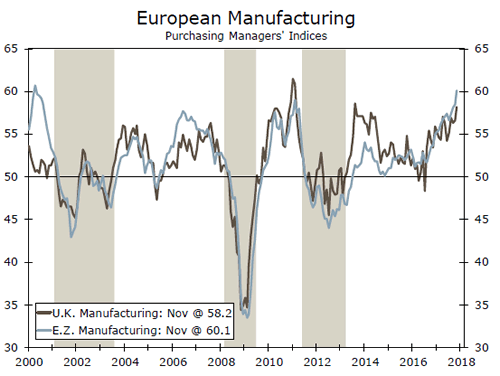
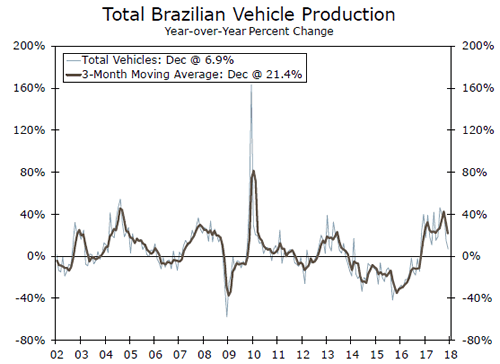
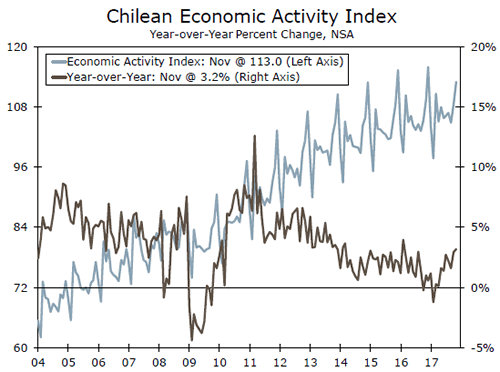
Global Outlook
Canadian Housing Starts • Monday
Residential construction activity in Canada has been trending higher for the past several years. In November, the annualized pace of housing starts crested above a quarter million. That is just spitting distance from the fastest pace seen over the past decade.
We do not forecast housing starts in Canada, but in past periods a surge like the one seen in November has proved to be short-lived, although the uptrend in the 12-month moving average suggests a firming trend. Despite some recent volatility in home prices, elevated values suggest some room in the market for new inventory.
Most of the action lately has been in multi-family with that series hitting 175,000 in November, an all-time high. December figures for housing starts will print on Monday of next week.
Previous: 252K Consensus: 190K
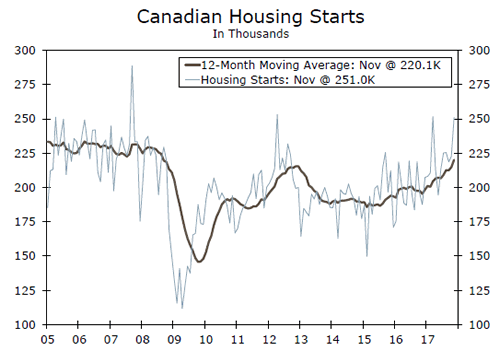
U.K. Industrial Production • Wednesday
Prospects for growth in the United Kingdom are dependent, at least to some degree, on the Brexit negotiation process. Unfortunately, there is simply no realistic way of knowing the outcome of that process at this time.
In this climate of uncertainty, we are particularly attentive to the risk that uncertainties might cause businesses to retrench via lower investment or to cut back on hiring, which could cause the British economy to weaken further.
Industrial production figures for November due out on Wednesday will offer a measure of activity in the factory sector. Output was flat in October after a 0.7 percent pick-up in the prior month. As the nearby chart shows, the year-over-year figures have been quite volatile in recent years. Even a modest monthly gain in November would likely still result in a dip in the year-over-year rate.
Previous: 3.6% (Year-over-Year) Consensus: 1.8%
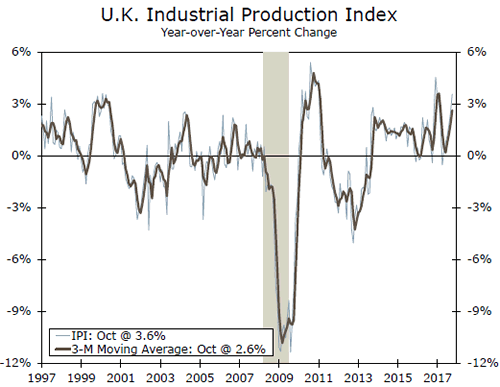
Australian Retail Sales • Wednesday
As the nearby chart shows, retail sales activity in Australia has seen the rate of growth trending lower over the past three years or so. Consumers in Australia face elevated levels of household debt as home prices have risen dramatically in some markets.
This problem has been compounded by the fact that wage growth has been under pressure in recent years making it harder for households to free up extra spending money.
The unemployment rate has been trending lower, however, and the 5.4 percent jobless rate in November was at a four-year low. Retail sales shot up 0.5 percent in October marking the second-largest monthly jump in store sales for 2017. The retail sales report for November will hit the wire on Thursday of next week and that will tell us how Aussie retailers were faring heading into the key summer selling months around Christmas.
Previous: 0.5% (Month-over-Month) Consensus: 0.4%
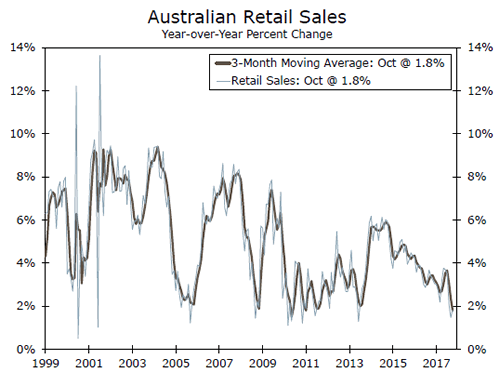
Point of View
Interest Rate Watch
Fed on Track for March Hike
Minutes from the December FOMC meeting suggest that the Fed will likely raise the fed funds rate again in March in what we believe will be the first of three rate increases this year. That comes despite some continued concerns about the outlook for inflation and more recent chatter about the flattening of the yield curve. Growth is expected to remain above its long-term rate next year, however, due in part to the tax bill providing a modest bump to consumer spending and capital investment.
Hinging on Inflation
Inflation remains the most prominent risk to the rate path. Inflation’s continued shortfall from the Fed’s target and lower inflation expectations led to dissents from Charles Evans and Neel Kashkari, but concern looked to extend to at least one other non-voter. Nevertheless, many members remain of the belief that as the labor market tightens, higher wages and inflation will follow.
The uncertainty surrounding which matters more for inflation over the medium term— lower expectations or slack—left inflation noted as both an upside and downside risk to the current path of rate hikes.
Yield Curve—Not Unusual
The flatter yield curve may have some analysts thinking the Fed may have to backoff their current rate path. Yet, despite Kashkari highlighting it in his dissent, the Committee largely remained unconcerned. Some flattening was to be expected with the FOMC raising short-term rates, and the degree of flattening "was not unusual by historic standards." When the spread between 10- and 2-year Treasuries was similarly narrow in the Spring 2005, the FOMC raised rates another nine times.
Financial Conditions—Still Easy
While some members look increasingly eager to demonstrate that the FOMC’s inflation goal is symmetric, a couple others noted that keeping policy highly accommodative continues to pose risks to financial stability. That risk, however, remains more difficult to measure than a two percent inflation goal.
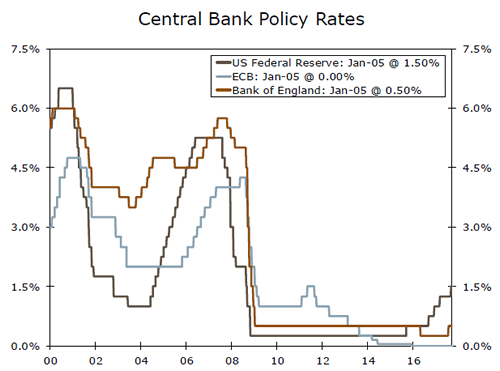
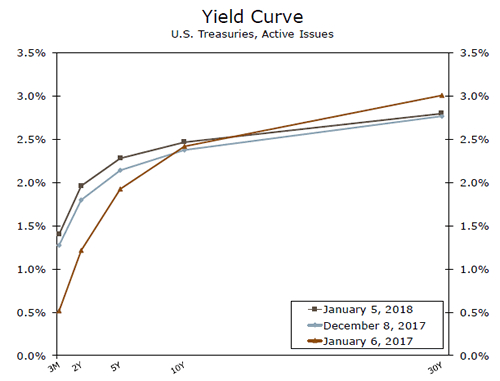
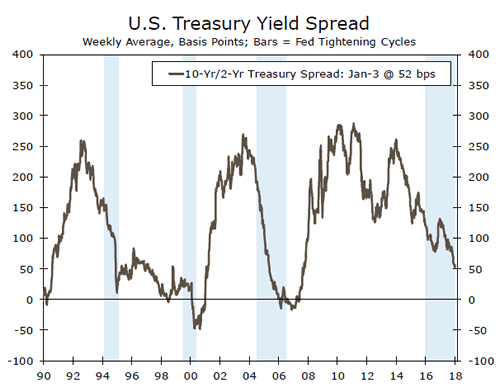
Credit Market Insights
Financial Conditions Remain Easy
Financial conditions remain easy compared to historical norms. While they tightened somewhat through the middle of 2017, conditions eased again in November and December, according to the Chicago Federal Reserve’s National Financial Conditions Index (NFCI). The NFCI summarizes 105 measures of financial activity. Decreasing risk, looser credit conditions and higher leverage are associated with a declines in the NFCI, and represent looser financial conditions.
Despite the Federal Open Market Committee (FOMC) raising rates three times in 2017 and beginning to wind down its balance sheet, the NFCI indicates that financial conditions have fallen to levels not seen since the mid-1990s. Recent strength in the economy may encourage investors to take on more leverage, which would contribute to lower values for the NFCI. However, even the adjusted NFCI, which controls for the state of the business cycle and level of inflation, shows that financial conditions have eased since late-2015 when the Fed began tightening monetary policy.
The NFCI suggests that consumers have been cushioned so far from the effects of a higher federal funds rate. However, we are expecting the FOMC to raise rates three more times in 2018, and with continued rate hikes financial conditions will likely tighten in the year ahead. However, historically low debt payment-to-income ratios mean that households will likely be able to manage somewhat tighter financial conditions.
Topic of the Week
Can Consumers Keep the Party Going?
The improvement in consumer confidence over the past year has been followed by a strong response from consumers as they dipped further into their pockets while bringing down the savings rate to complement the low rate of growth of disposable personal income. However, real disposable personal income growth has been improving lately, just in time to help consumers keep the current party going. Furthermore, the expectation of a still-strong employment market for this year and an even lower rate of unemployment should be enough to keep consumers happy. We should also see continued improvement in salaries and wages if the labor market continues to tighten as we are anticipating. At the same time, Americans are tapping into credit cards to complement the weak growth in disposable personal income. However, Americans do not seem to be overstretching in terms of credit card loans as revolving credit growth is still relatively low compared to the past and credit card delinquency rates remain low. Today, revolving credit is growing at about 5 to 6 percent on a year-earlier basis. Even the rate of growth of student loans has slowed down considerably over the past several years (bottom graph).
Will it be sustainable? The fact that the effects of the tax reform on disposable personal income will start to take effect in 2019 will probably give more staying power to the improvement in consumption. So yes, it should be sustainable at least until the end of 2019.
So what could go wrong? Inflation and higher-thanexpected interest rates. If the tax reform, i.e., fiscal policy, adds to stronger economic growth more than what we are estimating, then we could run into issues with higher inflation to a point that pushes the Federal Reserve to step up its tightening campaign. And for those who think that inflation is no longer a problem, we must remind them that we have been there before, when the talk was that the business cycle was dead and then the Great Recession put that thought to rest. That is, never underestimate the power of economic theory.
